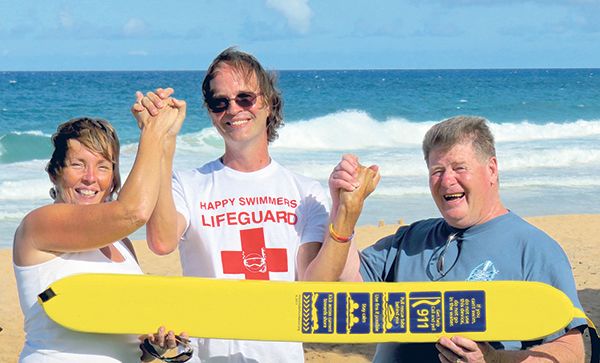Hawaii Rescue Tubes Save Lives on Public Beaches

The founder of JTA CPR, John Tyler started the non profit Rescue Tube operation on a Kauai beach in 2008. He was simply a good-hearted individual trying to create a system to save a few people from drowning each year.
Since then more than 70 lives have been saved on Kauai with Rescue Tubes, which is a wonderful outcome to this charity project started by a single lifeguard.
ŌĆ£When I first started we were losing about 12 people per year to drowning at our beaches, so I envisioned that number going down significantly, but I never imagined Rescue Tubes would save so many lives,ŌĆØ says John, clearly elated. ŌĆ£ItŌĆÖs beyond my dreams.ŌĆØ
Ingeniously simple, a Rescue Tube is a 50-inch long thick piece of foam that is buoyant enough to support three adults. An eight-foot long cord is attached to the tube making it quick and easy to drape over the rescuerŌĆÖs shoulder while swimming out. Silkscreened on one side of the tube are at-a-glance instructions of how to use the device.
ŌĆ£A Rescue Tube keeps a barrier between the rescuer and rescuee which is very important because you want them to grab something ŌĆō that is not you ŌĆō to keep them afloat,ŌĆØ John says. ŌĆ£If those tubes werenŌĆÖt there, I donŌĆÖt think so many people would have the courage to swim out and rescue people.ŌĆØ
DonŌĆÖt stop someone from doing good
When John first began placing Rescue Tubes on KauaiŌĆÖs beaches in Hawaii, he met some resistance and negativity. ŌĆ£I had a lot of naysayers,ŌĆØ he says. ŌĆ£I was only hanging them on trees at the start and people said they would get stolen or that there would be liability issues.
Two weeks after he hung a tube at Lumahai Beach on KauaiŌĆÖs north shore, a 15-year-old saved a 40-year-old with a Rescue Tube, keeping the man afloat and gently kicking toward shore until lifeguards arrived on jet-skis from Hanalei 20 minutes later.
Two more people who are grateful for JohnŌĆÖs determination are Corrinne ŌĆ£CoriŌĆØ and Craig Beck, owners of Garden Isle Bath & Body in Kapa’a, who were both caught in a rip tide at Moloaa Bay last September, a month before CraigŌĆÖs 70th birthday.
After swimming in the morning with friends then having lunch on the beach, Cori returned that afternoon to swim in the inviting crystal clear water.
ŌĆ£I was just floating around in the ocean and when I tried to swim in to shore, I was being pulled down and out,ŌĆØ Cori says.
Craig sensed something was wrong and began wading into the water to see what was happening. Cori called to him, ŌĆ£I canŌĆÖt get back in,ŌĆØ he swam out and was immediately caught in the undertow, too. ŌĆ£He got to me, then he went by me,ŌĆØ Cori says. ŌĆ£I heard him say, ŌĆśWe need some help out here.ŌĆÖ ŌĆ£
Cori and Craig were stunned – Both strong and athletic all of their lives, after struggling to stay afloat, they were exhausted. ŌĆ£Another 30 seconds, IŌĆÖd have been a casualty,ŌĆØ said Craig.
ŌĆ£I looked back at him, he just looked like heŌĆÖd given in to being lost at sea. He was drifting away from me,ŌĆØ Cori says, choking up.
Then seemingly out of nowhere, two young women about 19 years old swam out to Craig with a Rescue Tube and asked him, ŌĆ£Can you hang onto this?ŌĆØ He draped himself over the thick foam tube, began catching his breath and said to the women, ŌĆ£Oh you guys are beautiful. You have got to be angels.ŌĆØ Together the three gently kicked into shore and the two ladies hauled Craig onto his beach chair.
Meanwhile, a woman with a British accent, swam out to Cori and gave her a Rescue Tube. ŌĆ£I said, ŌĆśWhat about you?ŌĆÖ but she just swam away,ŌĆØ Cori says with gratitude.
The Becks donŌĆÖt know who their rescuers are as they disappeared as quickly as they appeared. They had the opportunity to meet John Tyler, the man who started Rescue Tubes project on Kauai. With tears his eyes, Craig gave John a big bear hug and said, ŌĆ£ItŌĆÖs because of you that weŌĆÖre alive.ŌĆØ
Extremely humble, John credits his kumu hula (hula instructor) Puna Dawson with encouraging him to keep placing Rescue Tubes around the island in the early years, regardless of what skeptics said. ŌĆ£She said when the intention is pure, people will support you.ŌĆØ
JohnŌĆÖs advice for others is to follow your heart. If you know something is helpful people will get behind it after they see itŌĆÖs working. We all have our own unique skills that can make the world a better place for others.

